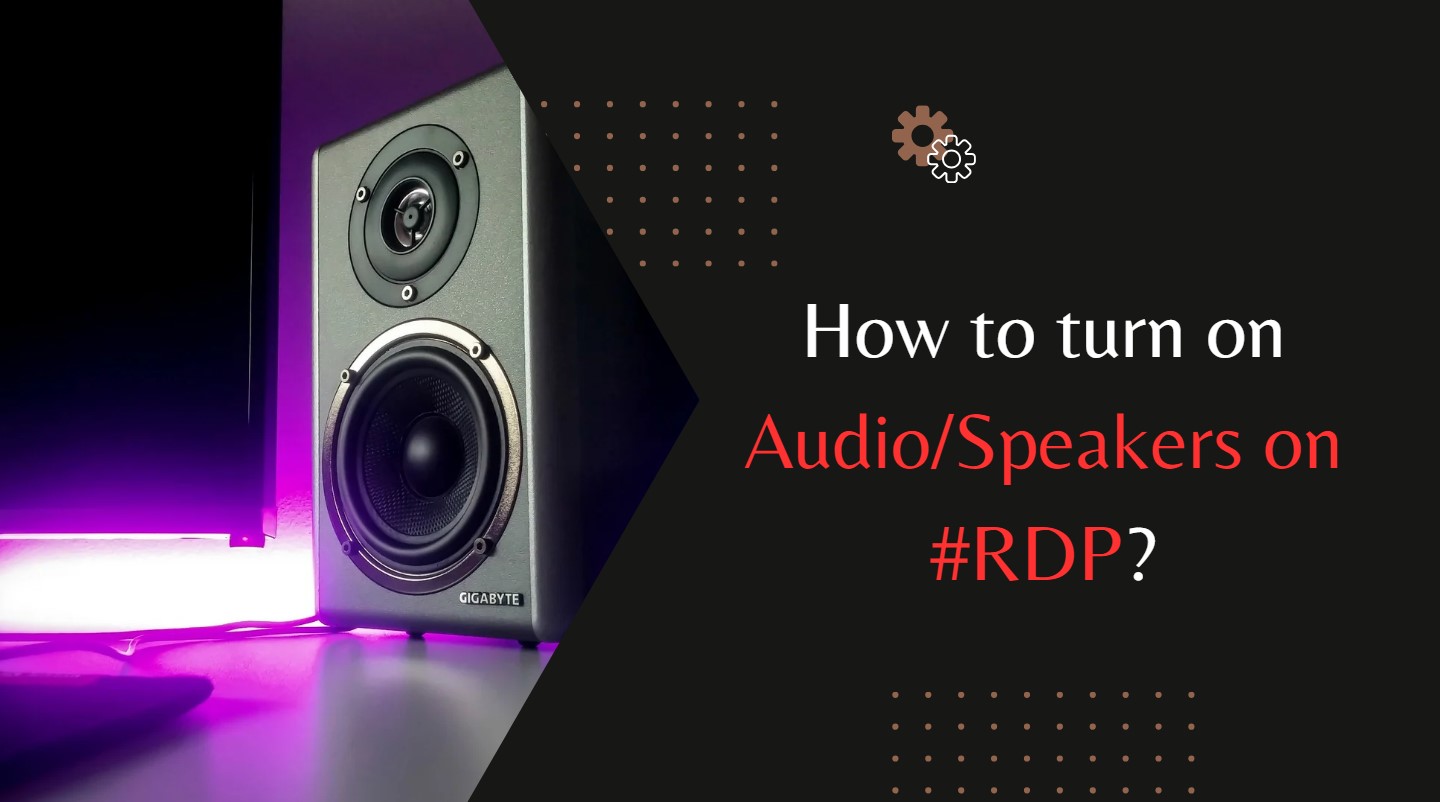RDP goes beyond eye touch to improve remote work. This article will enable RDP audio and speakers to change your virtual office completely. Microsoft’s RDP has become famous for remote work because it provides continuous access to faraway computers.
As remote work becomes more important, RDP audio is becoming more important. We’ll cover setup, common issues, and advanced options to give you an immersive audio experience.
Join us as we adjust your RDP settings to make working remotely more effective, enjoyable, and audio-enabled.
What is a Remote Desktop Connection?
RDP, or “remote desktop protocol,” enables user’s access to a desktop PC from anywhere. Thus, you may use it locally without traveling. Microsoft proposed it as Windows NT 4.0’s terminal service in 1998.
RDP helped several firms during the closure by letting staff work from home. In 2021, individuals choose home-based work.
Both allow workers to work remotely, but remote desktop access and cloud computing are distinct. One benefit of cloud computing is that users may access data and programs on faraway servers.
Comparison between RDP and Cloud Computing
Comparing remote desktop to cloud computing, remember that RDP can only visit the site with the data on the remote desktop. Cloud computing lets you access cloud server data. Cloud computing gives some flexibility and security, but RDP offers more.
Most remote desktop programs use TryRDP, while VNC, ICA, and RDP One are also available. RDP may be used on Mac and Linux, even though it was initially published by Microsoft and is used on most Windows-based OSes. RDP may be used without a VPN, which is great.
Data is saved on the user’s desktop, not vulnerable cloud servers or computers. Companies having an on-site IT infrastructure may enable SIP-based remote work.
How can I enable remote audio and speaker devices over RDP?
Check your RDP client settings after confirming that your VoIP program isn’t picking up your speaker or audio output.
1. Open RDP settings
Start improving your connection by opening the Remote Desktop Connection pane. The “Show Options” button opens the advanced options menu for further setup complexity. This initial step prepares for a more detailed investigation of your RDP settings.
2. Select ‘Local Resources’ to access remote audio playback options
Use the advanced options ‘Local Resources’ tab to alter how local and remote audio resources operate together. This tab is necessary for modifications. Below “Remote audio” is “Configure remote audio settings.” Here, you may fine-tune audio inputs and outputs. Before this delicate voyage, use “Settings…” to alter settings.
3. Tick “Play from this machine”
Examine the remote audio settings without interrupting the audio. Selecting “Play on this computer” is necessary for local playback. Switch “Record from this computer” to “On”. This is necessary to send your local microphone’s input. These traits may establish a strong local remote desktop connection. After making all the necessary adjustments, click OK. Next, check your VoIP program for “Remote Output” input and output devices. If challenges continue, go to the next strategic level.
4. Add functions to your server to boost its capabilities
Visit the Server Manager for any server setup needs. Adding roles and functionality to the server is our new priority. Select “Add roles and features” from the submenu under “Configure this local server.” A wizard will guide you through selecting the features and roles needed for maximum performance.
5. Allow remote desktop access
The Roles and Features wizard will offer to install based on roles or features. This is computed to meet your server’s needs. Remote Desktop Services starts when you identify your server at this vital point. To continue, click the next three times after checking “Remote Desktop Services”. This thoughtful move may provide the basis for complete remote desktop capabilities.
6. Choose the Remote Desktop service roles to install
To ensure microphone and audio compatibility, allocate responsibilities carefully. Consider choosing Remote Desktop Gateway, Session Host, Connection Broker, and Web Access. Due to their careful placement, the roles will work together to keep your microphone and other audio components running well. Continue clicking next until “Install” appears. Install and restart the system to make changes permanent.
7. Enable the Windows Audio service
Check the taskbar sound icon after restarting. Continue right-clicking the Red Cross to detect audio service issues if they persist. Windows Server detects system complexity and alerts. Your authorization is needed to activate the Windows Audio Service for audio integration. Click “Yes” to confirm your choice.
Following these detailed instructions will make adding your local audio and speaker to your Remote Desktop Connection a seamless and immersive experience. This extensive optimization ensures better VoIP conversation, proving smart settings’ potential.
For macOS
1. Download “Microsoft Remote Desktop” from the Mac App Store
Start by downloading the newest “Microsoft Remote Desktop” program from the Mac program Store. Keep your app updated to enjoy the latest features and get the best performance.
2. Add a PC to “Microsoft Remote Desktop”
Open the app and choose “PCs”. Click “+” to join a new PC. This is necessary to connect your Mac to the Windows-based VPS.
3. Find “Devices & Audio”
In the new PC settings, examine the configuration options. Locate “Devices & Audio”. Adjust online event music playback and redirection settings here.
4. Select music-playing options
Choose one based on your requirements and tastes:
- On this computer: Choose this to play remote screen sound on your Mac.
- On the remote PC: If you pick this option, the remote Windows PC will play sound.
- Never: This turns off audio playback during online events.
5. Press “Save”
After setting up the music, save your settings. This step finishes the configuration so the new audio settings operate automatically in your next remote desktop connection.
6. Allow Windows Audio on your VPS
Visit your Windows VPS after proper setup. Launch the “Services” app. Find “Windows Audio,” right-click, and choose “Start” to enable audio. This optimizes Windows audio.
Engaging with Remote Audio Devices
Enabling audio playback and recording in your RDP connection opens up many more options. These choices will let you sound like you’re in front of a distant computer. Audio features make remote desktop use easier and more versatile.
Playing Music or Media
RDP audio’s ability to play media on the remote computer is a major benefit. It contains music, movies, podcasts, etc. Continuous music broadcast via local speakers creates an immersive experience. This capability is handy for playing media from elsewhere or accessing internet feeds. It effectively converts your surroundings into a multimedia information hub.
Making Voice/Video Calls
Receiving audio via RDP simplifies the integration of Skype, Zoom, Teams, and other communication services. You may start voice and video chats from a distant computer using these programs. They’ll hear your built-in microphone and speakers easily. The nicest thing is that the other person doesn’t know you’re using RDP. Communication becomes more straightforward and more refined.
Verbal records
Document production is added by merging RDP audio with voice recognition software. Office programs’ dictation capability lets you record your voice via RDP for rapid document transcription on distant PCs. Voice-driven document developers need this functionality for quicker and more effective working.
Documenting Audiology
RDP audio lets users record sounds on the remote computer. Select the redirected microphone as the input source. This feature has several uses, including voiceovers, music recording, and podcasting. Audio recording in remote desktop environments is a tremendous advance that opens up many professional and creative possibilities.
Text-to-speech integration
Along with its many other applications, RDP audio supports text-to-speech engines. When you utilize RDP audio, these engines will effortlessly read aloud text via your local speakers since they are intended to do so. This feature improves accessibility and user experience by reading text aloud.
Accessing Virtual Assistants
Amazon Alexa and Microsoft Cortana support RDP audio. The speakers around you will enhance these artificial beings’ answers to your distant computer conversations. This smooths virtual assistant interaction, making it seem like you’re at a distant computer.
RDP audio’s expanded capabilities connect local and remote settings, enabling a more productive, creative, and collaborative digital workplace.
Troubleshooting Common Issues
Distant desktop protocol (RDP) can diagnose and fix audio issues on distant computers. RDP allows users to extensively test audio playback and device settings to find the source of difficulties. Troubleshooting ensures a fast and practical remote desktop experience.
Audio Production Remotely
RDP is a top service for audio engineers and composers. Anyone may produce audio without delay using remote editing and multitrack recordings. These characteristics enable musical engineers and producers to utilize their resources and ideas regardless of location.
Activity involving
Players who wish to become involved may use RDP. Since the game’s score and sound effects play uninterrupted, playing games on a distant PC won’t affect local speakers. This function extends the game world outside the local system, completely immersing remote gaming.
Phone Integration
Using particular software, PC and smartphone calls may be seamlessly integrated. Remote Desktop Protocol (RDP) lets people answer calls remotely, unifying communication. This connection helps customers manage their phone conversations while working remotely on a computer, improving connectivity and efficiency.
VoIP Intercom Systems
RDP connections help commercial VoIP intercom users in businesses and schools. Intercom systems often include administration software that may be accessed remotely via RDP. VoIP intercom systems may streamline communication in various contexts with this functionality.
Accessibility features
Using accessibility tools, operating systems with RDP audio may be enhanced easily. These include a narrator, closed captions that read text aloud, and a magnifying glass. Remote desktop users may utilize these features with accessibility requirements, creating an inclusive and user-friendly environment.
Two-way conversations
Distant Desktop Protocol allows audio input and output for two-way communications with persons at a distant computer. This feature makes remote support, troubleshooting, and collaboration easier, enabling efficient communication regardless of location.
Remote Conferencing
Remote Desktop Protocol lets users quickly attend online meetings, seminars, and conferences. RDP is used for remote conferencing. Audio allows attendees to communicate, exchange ideas, and contribute even if they’re not at the conference.
Optimizing RDP Audio Performance
After configuring RDP audio, extra steps are needed for a responsive and flawless experience. This maximizes performance and audio quality.
Update Audio Drivers
Updating audio drivers on local and distant PCs is essential for compatibility and performance. Outdated drivers might cause audio incompatibility. Update drivers periodically for maximum performance.
Test Your Microphone
Adjust the microphone volume if remote session participants can’t hear you. If the microphone doesn’t function, ensure it’s not muted and has no connection difficulties.
Wear Your Headset
A headset is best for RDP conversations and conferences if you want better sound than speakers and a microphone. Audio input and output control and concentration from headsets improve communication.
Add a USB Audio Device
Connect a USB microphone, speakers, or headset to your local or distant computer if the built-in audio sounds bad. USB connections may improve audio equipment compatibility and performance.
Adjust Windows Settings
Use Windows’ noise reduction, acoustic echo cancellation, and automatic gain control to optimize RDP voice performance. These settings may improve remote conference audio.
Check Audio Equipment
Check that the distant and local computers have the right playback and recording equipment. These settings must be checked carefully since incorrectly set up sound equipment might block audio transmission.
RDP users may produce high-quality, responsive audio by following these rules. This audio may be used for music, telephony, conferencing, and more. A well-configured RDP audio setup may give a smooth and immersive remote audio experience.
Conclusion
Remote work is more accessible and more immersive when audio and speakers are enabled on Remote Desktop Protocol (RDP). In a virtual conference, listening to music, or working on a creative project, allowing RDP audio will improve your remote desktop connection.
After reading this guide and applying its easy strategies, you can manage complicated settings, diagnose errors, and improve your audio system’s performance. As remote work evolves, a smooth and immersive RDP environment is needed. Now that RDP can send audio, you may use your virtual office fully. Have fun working remotely!





